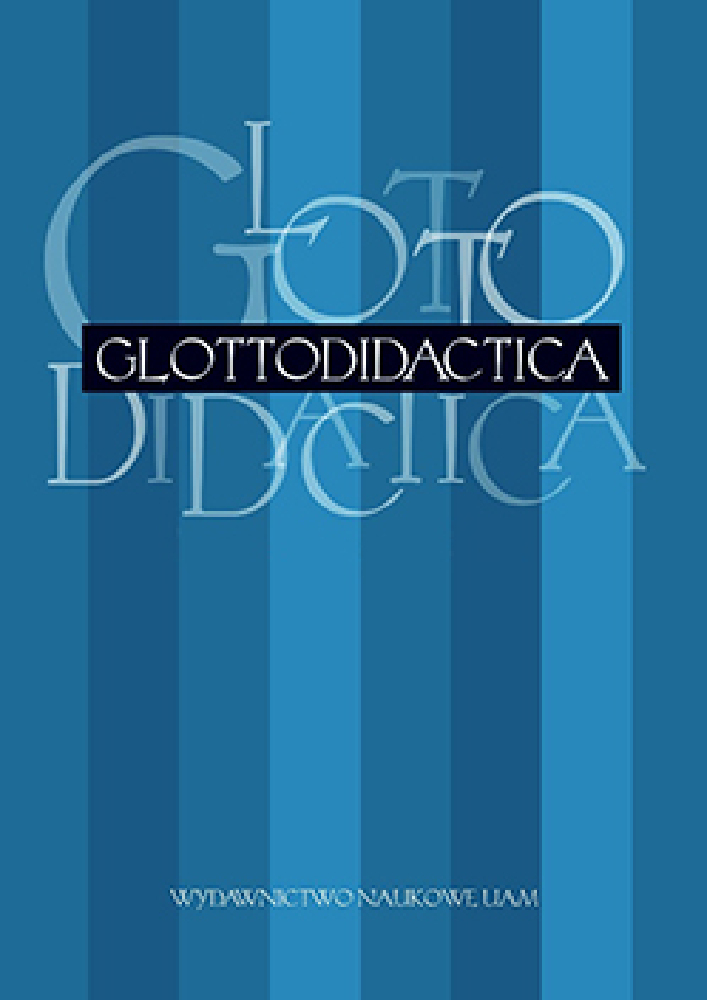Résumé
Language is considered a social phenomenon because all human beings communicate with their respective speech communities using the language of their own. Putnam’s theory of meaning combines such ingredients as the individual language experience world and social practice, all of which are ignored or downplayed by traditional theorizing about meaning. This article outlines some important aspects of Putnam’s idea and tries to answer the question of whether the stereotype semantics can solve the problem of meaning.Références
Bartmiński, J., 1988a. Słownik ludowych stereotypów językowych. Zeszyt próbny. Wrocław: Wydawnictwo Uniwersytetu Wrocławskiego.
Bartmiński, J., 1988b. Definicja kognitywna jako narzędzie opisu konotacji. In: Bartmiński, J. (red.), Konotacja. Lublin: UMCS, 169–182.
Bartmiński, J., 1998. Podstawy lingwistycznych badań nad stereotypem – na przykładzie stereotypu ‘matki’. In: Język a kultura 12, 63–83.
Bosch, P., 1985. Kontexte, Stereotype und Dynamik der Bedeutungskonstitution. In: Rieger, B. (Hrsg.), Dynamik in der Bedeutungskonstitution. Hamburg: Buske, 143–162.
Busse, D., 1992. Textinterpretation. Sprachtheoretische Grundlagen einer explikativen Semantik. Opladen: Westdeutscher Verlag.
Dahlgren, K., 1978. The Nature of Linguistic stereotypes. In: Farkas, D. / Wesley, M.J. / Karol, W. Todrys (eds), Papers from the Parasession on the Lexicon, April 14–15. Chicago: Chicago Linguistic Society, 58–70.
Dahlgren, K., 1988. Naive Semantics for Natural Language Processing. Boston: Kluwer Academic Publishers.
Eikmeyer, H.-J. / Rieser, H., 1981. Meanings, Intentions and Stereotypes: A New Approach To Linguistic Semantics. In: Eikmeyer, H.-J. / Rieser, H. (eds), Words, Worlds, and Contexts. New Approaches in Word Semantics. Berlin / New York: de Gruyter, 133–150.
Fraas, C., 1996. Gebrauchswandel und Bedeutungsvarianz in Textnetzen: Die Konzepte IDENTITÄT und DEUTSCHE im Diskurs zur deutschen Einheit. Tübingen: Gunter Narr.
Grzegorczykowa, R., 1998. O rozumieniu prototypu i stereotypu we współczesnych teoriach. In: Język a kultura 12, 109–115.
Kilian, J., 2003. Wörter im Zweifel. Ansätze einer linguistisch begründeten kritischen Semantik. In: Linguistik online 16/4.
Klein, J., 1998. Linguistische Stereotypbegriffe. Sozialpsychologischer vs. semantiktheoretischer Traditionsstrang und einige frametheoretische Überlegungen. In: Heinemenn, M. (Hrsg.), Sprachliche und soziale Stereotype. Frankfurt a.M. et al.: Lang, 25–46.
Konerding, K.-P., 2006. Der Einfluss der Stereotypentheorie von Hilary Putnam und ihre Rezeption und Weiterentwicklung in der Semantik. In: Auroux, S. (Hrsg.), Geschichte der Sprachwissenschaften. Ein internationales Handbuch zur Entwicklung der Sprachforschung von den Anfängen bis zur Gegenwart. Berlin, New York: de Gruyter, 2612–2626.
Lakoff, G., 1987. Women, fire, and dangerous things: What categories reveal about the mind. Chicago: University of Chicago.
Loppe, T., 2010. Bedeutungswissen und Wortgebrauch: Entwurf einer Semantik im Anschluss an Wittgenstein und Putnam. Tübingen: Narr Francke Attempto Verlag.
Lutzeier, P.R., 1981. Wort und Feld. Wortsemantische Fragestellungen mit besonderer Berücksichtigung des Wortfeldbegriffes. Tübingen: Niemeyer.
Lutzeier, P.R., 1985. Linguistische Semantik. Stuttgart: Metzler.
Pajdzińska, A., 1988. Udział konotacji leksykalnej w motywacji frazeologizmów, In: Bartmiński, J. (red.), Konotacja. Lublin: UMCS, 67–82
Polański, K., (red.), 1999. Encyklopedia językoznawstwa ogólnego. Wrocław, Warszawa, Kraków: Zakład Narodowy im. Ossolińskich.
Pörings, R. / Schmitz, U., 2003. Sprache und Sprachwissenschaft. Eine kognitiv orientierte Einführung, Tübingen: Narr.
Putnam, H., 1975. The Meaning of “Meaning”. In: Gunderson, K. (ed.), Language, Mind and Knowledge: Minnesota Studies in the Philosophy of Science, Vol. 7. Minneapolis: University of Minnesota Press, 131–193. (Dt. 1979. Die Bedeutung von Bedeutung. Frankfurt am Main: Klostermann).
Rosch, E., 1975. Cognitive representations of semantic categories. In: Journal of Experimenal Psychology 104, 192–233.
Roth, E.M. / Shoben, E.J., 1983. The effects of context on the structure of categories. In: Cognitive Psychology 15/3, 346–378.
Schmid, H.-J., 2002. Die Stereotypensemantik. In: Cruse, D.A. / Hundsnurscher, F. / Lutzeier, P.R. (Hrsg.), Lexikologie. Lexicology. Ein internationales Handbuch zur Natur und Struktur von Wörtern und Wortschätzen. Berlin, New York: de Gruyter, 291–296.
Schwarze, C., 1982. Stereotyp und lexikalische Bedeutung. In: Studium Linguistik 13, 1–16.
Tokarski, R., 1987. Znaczenie słowa i jego modyfikacje w tekście. Lublin: UMCS.
Tokarski, R., 1988. Konotacja jako składnik treści słowa. In: Bartmiński, J. (red.), Konotacja. Lublin: UMCS. 35–54.
Welsh, C., 1983. Putnam’s Stereotypes and Compositionality. In: Papers from the Regional Meeting. Chicago: Chicago Linguistic Society, 396–407.
Wiegand, H.E. / Wolski, W., 1980. Lexikalische Semantik. In: Althaus, H.P. / Henne, H. / Wiegand, Herbert E. (eds.), Lexikon der Germanistischen Linguistik. Tübingen: Niemeyer, 155–180.
Licence
Auteurs
Les auteurs de textes acceptés pour publication dans la revue Glottodidactica sont tenus de remplir, signer et renvoyer à l'adresse de la rédaction, un accord sur l'octroi d'une licence gratuite pour les œuvres, avec obligation d'accorder une sous-licence CC.
Conformément à cet accord, les auteurs des textes publiés dans la revue Glottodidactica accordent à l'Université Adam Mickiewicz de Poznań une licence non exclusive et gratuite et autorisent l'utilisation de la sous-licence Creative Commons Attribution-NoDerivatives 4.0 International (CC BY-ND 4.0).
Les auteurs se réservent le droit de disposer librement de l'œuvre.
Utilisateurs
Les utilisateurs d'Internet intéressés ont le droit d'utiliser les œuvres publiées dans la revue Glottodidactica depuis 2016, selon les conditions suivantes :
- Attribution – obligation de fournir, conjointement avec l'œuvre distribuée, des informations sur l'auteur, le titre, la source (lien vers l'œuvre originale, DOI) et la licence elle-même.
- Aucune modification – l'œuvre doit être préservée dans sa forme originale. Sans le consentement de l'auteur, il n'est pas possible de distribuer l'œuvre modifiée sous forme de traductions, publications, etc.
Les droits d'auteur sont réservés pour tous les textes publiés avant 2016.
Autres
L'Université Adam Mickiewicz de Poznań conserve les droits sur la revue dans son ensemble (mise en page, forme graphique, titre, conception de la couverture, logo, etc.).
A PARTIR DE L’ANNEE 2015, LES ARTICLES PUBLIÉS DANS LA REVUE SONT DISPONIBLES SOUS LICENCE CREATIVE COMMONS : https://creativecommons.org/licenses/by-nd/4.0/deed.fr




